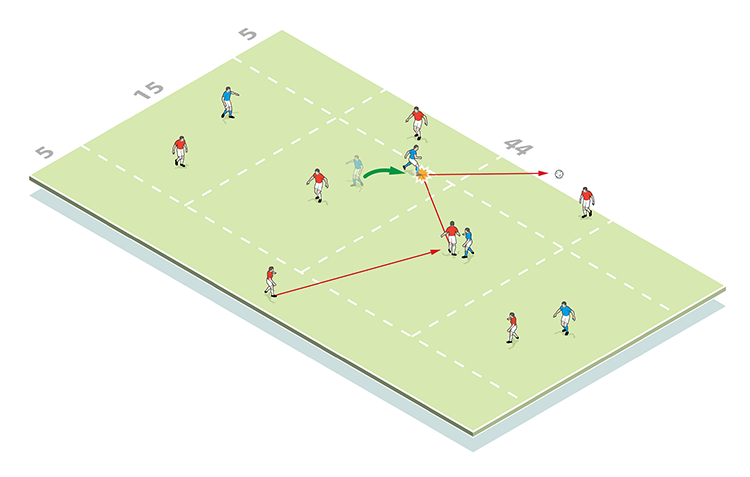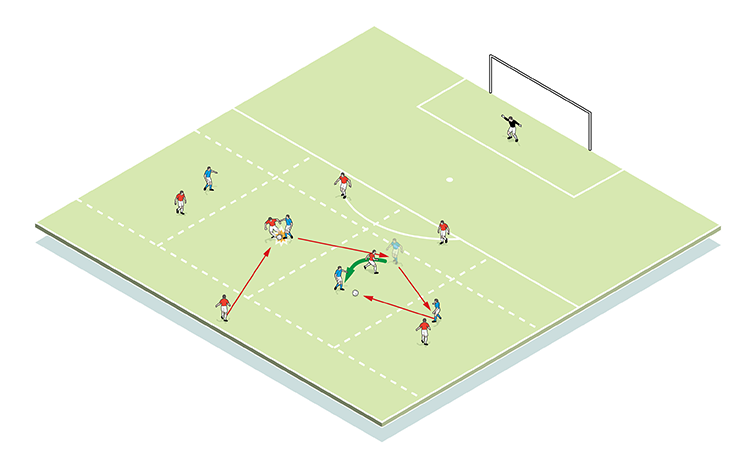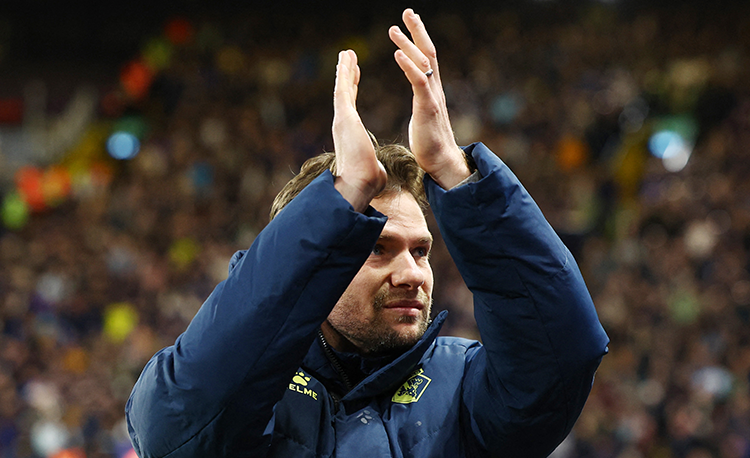You are viewing 1 of your 1 free articles
Defending principles in units
This session is about working with team mates to stop opposition teams playing beyond you, by simple balance and communication that can be taken into a bigger realistic practice.
| Area | Up to 44x43 yards |
| Equipment | Balls, cones, goal |
| No. of Players | Up to 11 |
| Session Time | 35mins |
This session is about working with team mates to stop opposition teams playing beyond you, by simple balance and communication that can be taken into a bigger realistic practice.
Players at all levels need to be reminded of the principles outlined in this session. After all, more and more now, opposition teams are playing good football between the lines, so poor defensive shape and balance can leave players and defences exposed.
We saw the positive elements of this session come forward in our recent FA Cup second round match at MK Dons. Although we lost the game in injury-time, we succeeded in nullifying the hosts’ significant attacking threat in central areas.
What do I get the players to do?
Using a 44x25-yard area, we set up as shown. In the bottom channel is the server, while in the other we place two centre-forwards.
The server begins by playing in to any of his team mates (1a). Receiving players have three options:
(a) Play back to the server (one- or two-touch)
(b) Play sideways to a team mate in any of the other three boxes (1b)
(c) play into a centre-forward in the end zone (1c)
1a

1b

1c

Attacking centre-forwards in the end zone can only receive passes in a different box to the player passing to him. Doing so earns them a point.
Defenders have to stay in their zones until the ball is moved into the end zone, at which point they can recover into any area. Good covering is essential so easy passes aren’t allowed into the centre-forwards. Defenders score by turning over possession, then making three passes or laying back to the server.
What are the key things to look out for?
Defenders must press at high-intensity. They need to know what’s behind them to help the angle of the press, and must communicate with and cover team mates to stop the ball being played between them. They should never be square of one another, and must be ready to make recovery runs after pressing, or when the ball goes beyond them.
How do I progress the session?
Now add a penalty area beyond the end zone, with a goal and keeper in place (2). Here, we offer an added opportunity for the receiving player who, if he beats the defender 1v1 and moves into the end zone, can have an attempt on goal - scoring earns an additional point.
2

Alternatively, the forward can make a one-two with the centre-forward before an attempt on goal, but centre-forwards cannot turn and score (3). For a point, defenders still need to make three passes (4) or must feed the ball back to the server.
3

4

Related Files
Editor's Picks
Deep runs in the final third
Using the goalkeeper in build-up play
Pressing principles
Intensive boxes drill with goals
Penetrating the final third
Creating and finishing
My philosophy
Pressing initiation
Compact team movement
Coaches' Testimonials

Alan Pardew

Arsène Wenger

Brendan Rodgers

Carlos Carvalhal

José Mourinho

Jürgen Klopp

Pep Guardiola

Roy Hodgson

Sir Alex Ferguson

Steven Gerrard
Coaches' Testimonials

Gerald Kearney, Downtown Las Vegas Soccer Club

Paul Butler, Florida, USA

Rick Shields, Springboro, USA

Tony Green, Pierrefonds Titans, Quebec, Canada
Join the world's leading coaches and managers and discover for yourself one of the best kept secrets in coaching. No other training tool on the planet is written or read by the calibre of names you’ll find in Elite Soccer.
In a recent survey 92% of subscribers said Elite Soccer makes them more confident, 89% said it makes them a more effective coach and 91% said it makes them more inspired.
Get Monthly Inspiration
All the latest techniques and approaches
Since 2010 Elite Soccer has given subscribers exclusive insight into the training ground practices of the world’s best coaches. Published in partnership with the League Managers Association we have unparalleled access to the leading lights in the English leagues, as well as a host of international managers.
Elite Soccer exclusively features sessions written by the coaches themselves. There are no observed sessions and no sessions “in the style of”, just first-hand advice delivered direct to you from the coach.









